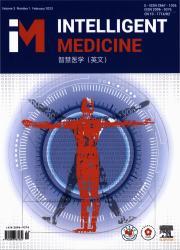Deep learning-based identification and localization of intracranial hemorrhage in patients using a large annotated head computed tomography dataset: A retrospective multicenter study
IF 6.9
Q1 COMPUTER SCIENCE, INTERDISCIPLINARY APPLICATIONS
引用次数: 0
Abstract
Background
Accurately identifying and localizing the five subtypes of intracranial hemorrhage (ICH) are crucial steps for subsequent clinical treatment; however, the lack of a large computed tomography (CT) dataset with annotations of the categorization and localization of ICH considerably limits the development of deep learning-based identification and localization methods. We aimed to construct this large dataset and develop a deep learning-based model to identify and localize the five ICH subtypes, including intraventricular hemorrhage (IVH), intraparenchymal hemorrhage (IPH), subdural hemorrhage (SDH), subarachnoid hemorrhage (SAH), and epidural hemorrhage (EDH), in non-contrast head CT scans.
Methods
Based on the public Radiological Society of North America (RSNA) 2019 dataset, we constructed a large CT dataset named RSNA 2019+ that was annotated for bleeding localization of the five ICH subtypes by three radiologists. An improved YOLOv8 architecture with the bidirectional feature pyramid network was proposed and trained using the RSNA 2019+ training dataset and evaluated on the RSNA 2019+ test dataset. The public CQ500, and two private datasets collected from the Xinqiao and Sunshine Union Hospitals, respectively, were also annotated to perform multicenter validation. Furthermore, the performance of the deep learning model was compared with that of four radiologists. Multiple performance metrics, including the average precision (AP), precision, recall and F1-score, were used for performance evaluation. The McNemar and chi-squared tests were performed, and the 95% Wilson confidence intervals were given for the precision and recall.
Results
There were 175,125; 4,707; 8,259; and 3,104 bounding boxes after annotation on the RSNA 2019+; CQ500+; and the PD 1 and PD 2 datasets, respectively. With an intersection-over-union threshold of 0.5, the APs of IVH, IPH, SAH, SDH and EDH are 0.852, 0.820, 0.574, 0.639, and 0.558, respectively, yielding a mean average precision (mAP) of 0.688 for our proposed deep learning model on the RSNA 2019+ test dataset. For the multicenter validation involving the three external datasets, the mAPs for CQ500, PD1, and PD2 were 0.594, 0.734, and 0.66, respectively, which is comparable to those of radiologist with eight years of experience in head CT interpretation.
Conclusion
The deep learning model developed from the constructed RSNA 2019+ dataset exhibited good potential in identifying and localizing the five ICH subtypes in CT slices and has the potential to assist in the clinical diagnosis.
基于深度学习的颅内出血患者识别和定位:一项回顾性多中心研究
背景准确识别和定位颅内出血(ICH)的五种亚型是后续临床治疗的关键步骤;然而,缺乏具有ICH分类和定位注释的大型计算机断层扫描(CT)数据集极大地限制了基于深度学习的识别和定位方法的发展。我们的目标是构建这个庞大的数据集,并开发一个基于深度学习的模型,以识别和定位脑室内出血(IVH)、脑内出血(IPH)、硬膜下出血(SDH)、蛛网膜下腔出血(SAH)和硬膜外出血(EDH)等5种脑室内出血亚型。方法基于北美放射学会(RSNA) 2019年的公共数据集,我们构建了一个名为RSNA 2019+的大型CT数据集,该数据集由3名放射科医生对5种ICH亚型的出血定位进行了注释。提出了一种带有双向特征金字塔网络的改进YOLOv8架构,并使用RSNA 2019+训练数据集进行了训练,并在RSNA 2019+测试数据集上进行了评估。公共CQ500以及分别从新桥医院和阳光联合医院收集的两个私人数据集也被注释以进行多中心验证。此外,将深度学习模型的性能与四位放射科医生的性能进行比较。采用平均精确度(AP)、精确度(precision)、召回率(recall)和f1分(F1-score)等多个性能指标进行性能评价。进行McNemar检验和卡方检验,并给出精确度和召回率的95% Wilson置信区间。结果共175125例;4707年;8259年;RSNA 2019+标注后的3104个边界框;CQ500 +;PD 1和PD 2数据集。在交叉超并阈值为0.5的情况下,IVH、IPH、SAH、SDH和EDH的ap分别为0.852、0.820、0.574、0.639和0.558,在RSNA 2019+测试数据集上,我们提出的深度学习模型的平均精度(mAP)为0.688。对于涉及三个外部数据集的多中心验证,CQ500、PD1和PD2的map分别为0.594、0.734和0.66,与具有8年头部CT解释经验的放射科医生相当。结论基于构建的RSNA 2019+数据集构建的深度学习模型在CT切片中5种ICH亚型的识别和定位方面具有良好的潜力,具有辅助临床诊断的潜力。
本文章由计算机程序翻译,如有差异,请以英文原文为准。
求助全文
约1分钟内获得全文
求助全文
来源期刊

Intelligent medicine
Surgery, Radiology and Imaging, Artificial Intelligence, Biomedical Engineering
CiteScore
5.20
自引率
0.00%
发文量
19
 求助内容:
求助内容: 应助结果提醒方式:
应助结果提醒方式:


